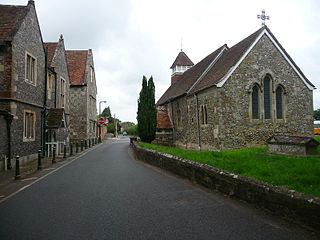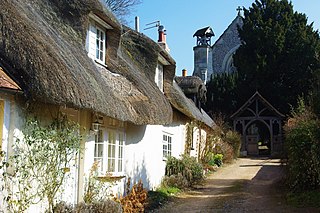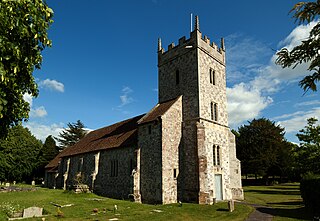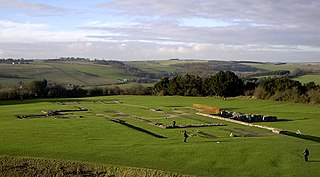
Salisbury is a cathedral city in Wiltshire, England with a population of 41,820, at the confluence of the rivers Avon, Nadder and Bourne. The city is approximately 20 miles from Southampton and 30 miles from Bath.

Old Sarum, in Wiltshire, South West England, is the now ruined and deserted site of the earliest settlement of Salisbury. Situated on a hill about two miles north of modern Salisbury near the A345 road, the settlement appears in some of the earliest records in the country. It is an English Heritage property and is open to the public.

Easton Royal is a village in the civil parish of Easton in Wiltshire, England, about 3 miles (5 km) east of Pewsey and 5 miles (8 km) south of Marlborough. The village was the location of Easton Priory from 1234 to 1536. The village mistakenly gained the Royal suffix in 1838 and the name Easton Royal has been in general use since the 1850s.

Ramsbury is a village and civil parish in the English county of Wiltshire. The village is in the Kennet Valley near the Berkshire boundary. The nearest towns are Hungerford about 4.5 miles (7.2 km) east and Marlborough about 5.5 miles (8.9 km) west. The much larger town of Swindon is about 12 miles (19 km) to the north.

Wiltshire is a historic county located in the South West England region. Wiltshire is landlocked and is in the east of the region.

Winterslow is a civil parish with a population of around 2,000, about 6 miles (10 km) northeast of Salisbury in Wiltshire, England, and lying south of the A30 London Road. It is sited on the Roman road between Old Sarum and Winchester.

Dinton is a village, civil parish and former manor in Wiltshire, England, in the Nadder valley on the B3089 road about 8 miles (13 km) west of Salisbury. The parish population was 696 at the 2011 census, estimated at 733 in 2019. The civil parish includes the village of Baverstock, about 1 mile (1.6 km) east of Dinton village.

Sarum College is a centre of theological learning in Salisbury, England. The college was established in 1995 and sits within the cathedral close on the north side of Salisbury Cathedral.

Bemerton, once a rural hamlet and later a civil parish to the west of Salisbury, Wiltshire, England, is now a suburb of that city. Modern-day Bemerton has areas known as Bemerton Heath, Bemerton Village and Lower Bemerton.

The Bishop of Salisbury is the ordinary of the Church of England's Diocese of Salisbury in the Province of Canterbury. The diocese covers much of the counties of Wiltshire and Dorset. The see is in the City of Salisbury where the bishop's seat is in the Cathedral Church of the Blessed Virgin Mary. The current bishop is Stephen Lake.

Potterne is a village and civil parish in the county of Wiltshire, England. The village is 2 miles (3.2 km) south of Devizes and lies on the A360 which links Devizes to Salisbury. The civil parish includes the hamlet of Potterne Wick.

Cholderton, or more properly West Cholderton, is a village and civil parish in the Bourne Valley of Wiltshire, England. The village is about 4 miles (6 km) east of the town of Amesbury. It is on the A338, about 1 mile (1.6 km) south of the A303 trunk road and 9 miles (14 km) northeast of Salisbury.

Stratford-sub-Castle in Wiltshire, England, was anciently a separate village and civil parish, but since 1954 has been a northern suburb of the city of Salisbury. At approximately 170 ft above sea level, it is dominated to the east by the remains of an Iron Age hillfort within the boundaries of which a Norman castle was built. This now-ruined castle led to the village taking the name Stratford-under-Castle, later changing to Stratford sub Castle. Stratford lies south-west of the abandoned medieval settlement of Old Sarum which was also built within the area of the hill fort. It is approximately twenty one miles from Southampton.

Salisbury Cathedral School is a co-educational independent school in Salisbury, Wiltshire, England, which was founded in 1091 by Saint Osmund. The choristers of Salisbury Cathedral are educated at the school.

Chilmark is a Wiltshire village and civil parish of some 150 houses straddling the B3089 road, 11 miles (18 km) west of Salisbury, England. The parish includes the hamlets of Mooray and Portash, both close to the south of Chilmark village; and the dispersed hamlet of Ridge, to the southwest.

St Lawrence's Church at Stratford-sub-Castle is a 13th-century Grade I listed Church of England parish church, to the north of Salisbury, Wiltshire, England. It stands close to the abandoned settlement of Old Sarum and the River Avon, and is about 2 miles (3.2 km) north of Salisbury Cathedral.

Old Sarum Cathedral was a Catholic and Norman cathedral at old Salisbury, now known as Old Sarum, between 1092 and 1220. Only its foundations remain, in the northwest quadrant of the circular outer bailey of the site, which is located near modern Salisbury, Wiltshire, in the United Kingdom. The cathedral was the seat of the bishops of Salisbury during the early Norman period and the original source of the Sarum Rite.

Laverstock is a village and civil parish on the north-east and east outskirts of Salisbury in the ceremonial county of Wiltshire, England. The parish is shaped like a figure 7 and incorporates Ford hamlet, the eastern half of the former manor of Milford, the area near the ancient settlement of Old Sarum, and part of the Hampton Park district on the edge of Salisbury.
William Buckner (1605–1657) was an English Anglican priest in the 17th century, who held the office of Archdeacon of Sarum from 1643.



















